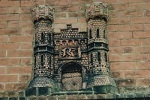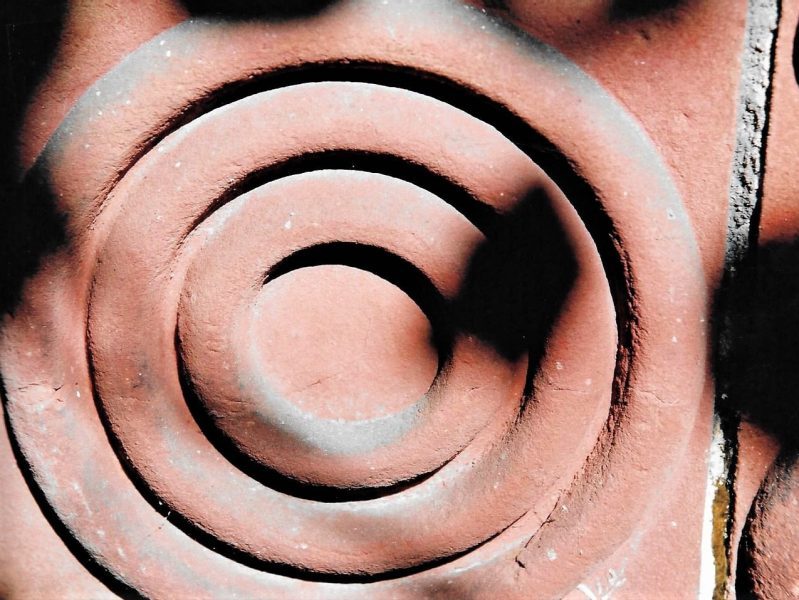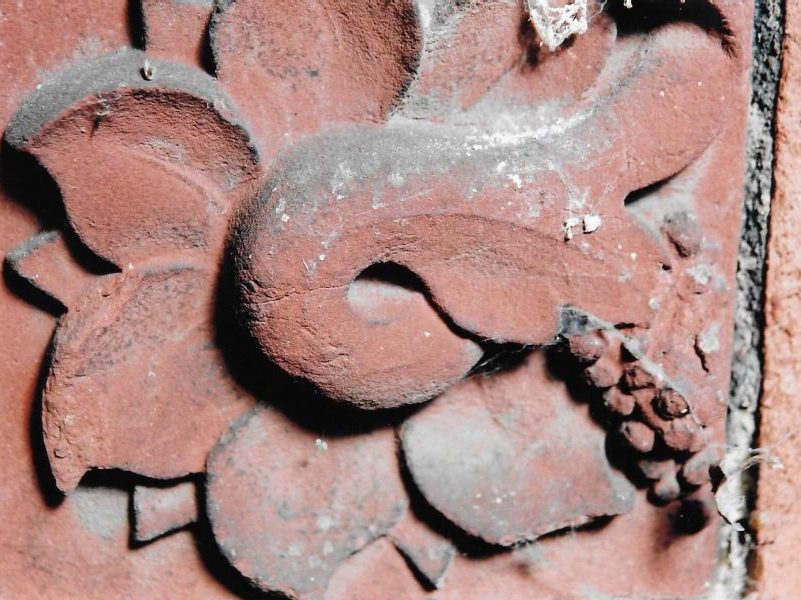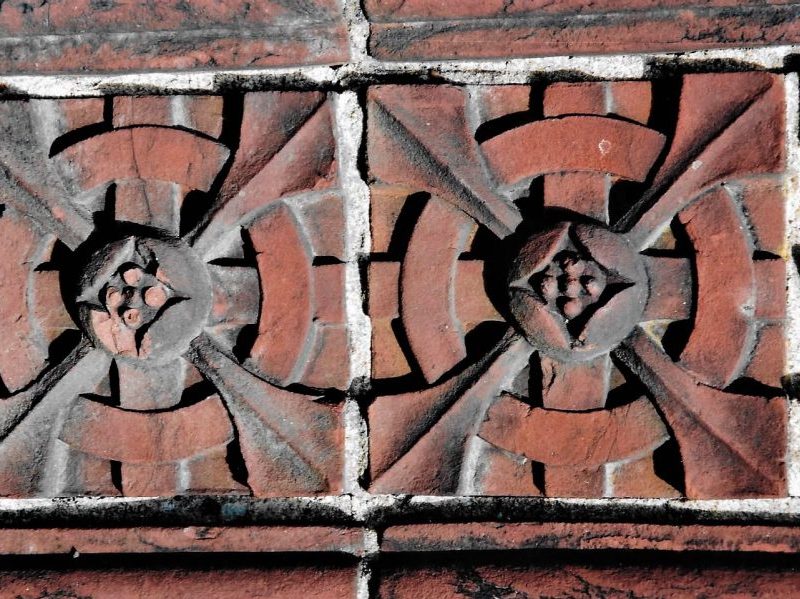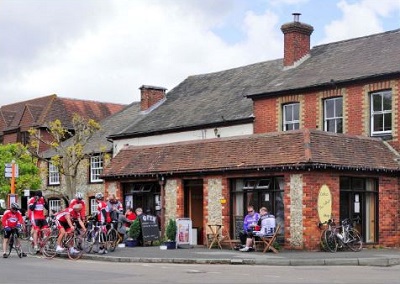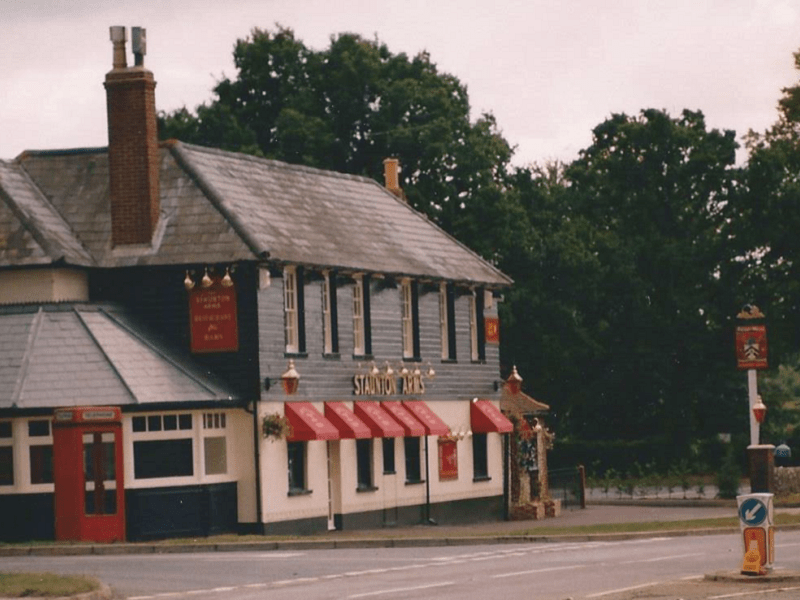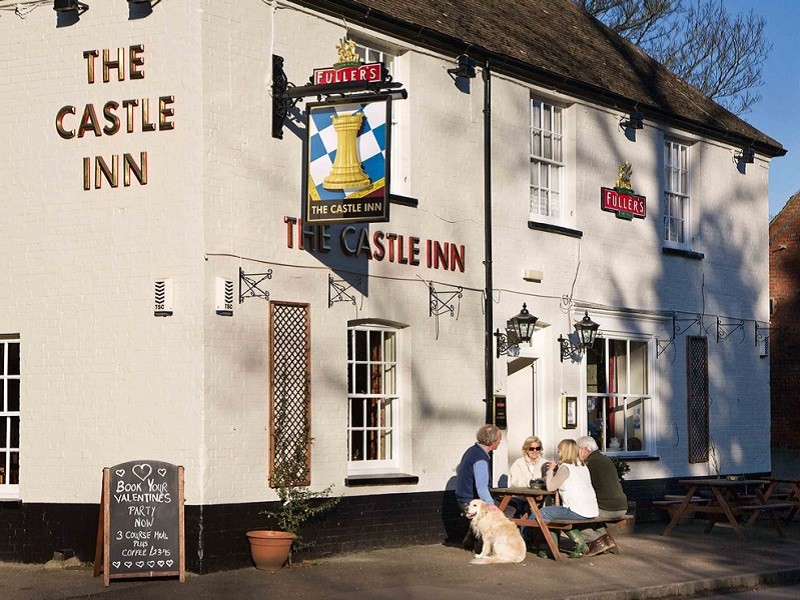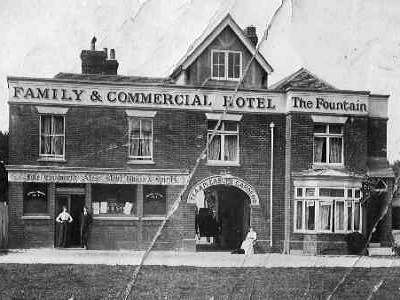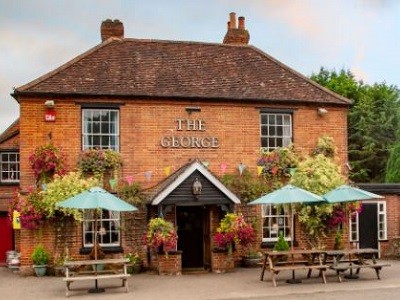Businesses of the Past
In the 1960s the village of Rowlands Castle was expanding. The development of the central land between Bowes Hill and Links Lane added many good quality homes. Few of these new residents would have been aware that a few hundred yards to the south of their prestigious developments was an industrial remnant, the Brickworks, virtually unchanged from Victorian times. Rowlands Castle has seen many businesses come and go since then but the situation today is that there are a large number of thriving businesses in and around the village. Those businesses which no longer exist but have played important roles in the village’s growth are documented below.
The Brickworks
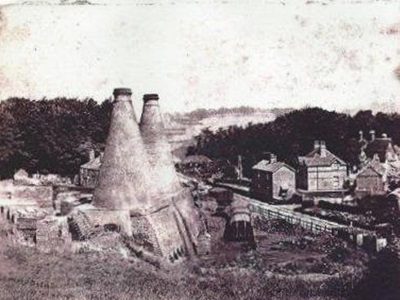
Rowlands Castle 1880-1968
Two very interesting and thorough articles on the brickworks have been written by village historians:
Brief history of the Rowland’s Castle Brick and Tile Works by courtesy of Dr Jonathon Dicks who retains the copyright and The Brickworks and The Village which was researched and written by Malcolm Smith, who thanks Ted Redsull and Paul Marshman.
Rik Goodall has written an account of his time working in the Brickworks during the 1950s and 60s.
This was a large area of brickyard workings, established during the 1880s, which had completely altered the landscape just out of sight of these residents. Here a small number of workers toiled daily in very harsh, almost Victorian primitive working conditions, mostly out of doors and in all weathers. (Smith, 2016)
Examples of Ornamental Bricks from Rowlands Castle
Rowlands Castle Brick and Tile Works (SU 734 104) provided the building material for several major civic and public buildings such as Portsmouth dockyards, the Hotel Metropole in Brighton, Hackney College in London, Stansted and Ditcham Houses in Hampshire as well as many local houses. Production ceased in 1968 and the majority of the area of about twenty acres including the clay pits, was cleared in 1971. The site was then occupied by a builder’s merchant with little evidence remaining of brick manufacture. (Dicks, 2015)
Canning Iron Works

Finchdean 1816-1935
Although all early records of the Iron Works business have long since disappeared, it is said to have been set up in 1816 by John Cannings in partnership with a Mr Howell. Long lost local legend once had it that they were commercial travellers in ironware who decided to go into production and that Cannings came from Andover. (Wall, 2003)
Read an in-depth history of the Finchdean Old Foundry in Vintage Spirit magazine article ‘Lifting the Lid of the Cannings’ Works written by Mike Wall.
The Old Forge Pottery

Rowlands Castle c1970-1990
The Old Forge Pottery in Durrants Road made a wide range of pottery in the studio and sold it in their small shop. It closed in the 1990s when the owner, Harry Clarke, retired. It is now a private residence. Harry is shown below working in his studio along with some of the items he created.
Every child at St John’s Primary School received a commemorative mug to celebrate the new school being open for 10 years. The Old Forge Pottery made the mugs with the winning design by one of the children.
Shops and Cafés
There has been a cluster of shops and places of refreshment around the Village Green since the mid 19th century. Because the village was on the direct London to Portsmouth railway line, it became a destination for Victorian day trippers. Today, the shops and cafes serve the local community as well as visitors.

Rook’s Stores was at the end of the village, near the railway arches from about 1840. The original building, a bakery, was built in around 1816. The Rook family had several business interests in Rowlands Castle during the nineteenth century, including a butchers, grocers and a Post Office in this building.

The shop was taken over by Wigginton and Herne from 1931. They ran a grocery store, with their own liveried delivery van.
In 1984, the Hall family took over the building and it became a car showroom for a time, as part of the Garage business.

The Coffee Pot café was towards the centre of the Green and was opened in 1982 by Mary Jane Lomer. It was particularly popular on Sundays when local residents and cyclists called for “a pot of tea for one, please” before clearing her selection of cakes! She also taught many teenagers “to cook, add up, and mix with customers”. The Coffee Pot closed in 2001.
Public Houses
The Staunton Arms
Named after Sir George Staunton, who did so much to create and develop the Leigh Park Estate, the Staunton Arms is now part of the Harvester national chain of restaurants. Situated at the crossroads leading from Durrants to Redhill the property itself dates from the early 19th century. Early maps and illustrations show the inn and stables as separate buildings, although it was a popular stopping off point for travellers it was never a Coaching Inn but more of a place to change horses.
In 1824 Sir George Staunton is reputed to have acquired a public house at Durrants, which was almost certain to have been the old Robin Hood Inn, formerly known in recent years as the Old Forge Pottery.
Extracts from The Inns and Public Houses of Rowlands Castle, Durrants, Redhill, Finchdean, Forestside and Stansted, written by Steve Jones and photos from Alf Harris.
The Castle Inn
The Castle Inn was built in 1853, just before the advent of the railway in 1859. It replaced The Old White Hart Ale House, which previously occupied a nearby site, and was the haunt of members of the Hawkhurst Gang of Smugglers. In 1748, which were darker times, the landlady Mrs Payne welcomed the gang and helped to send two customs officers on the path to their murders. The Old White Hart Inn was demolished to make way for the railway and the two arches built to support it changed the whole look of the village. (Lomer, 2015)
Today, The Castle Inn is a much friendlier place and belongs to Fuller’s Brewery. Under the tenancy of Sarah Mayes, the pub now offers food and drink in its bar and restaurant and has a large beer garden with a range of play equipment to keep children entertained.
An entrance into Stansted Forest is directly opposite so it is a good place to refresh yourself after a nice walk. The pub is dog friendly. Website: The Castle Inn
The Fountain Inn
It is in 1815 that the name ‘Fountain Inn’ is mentioned for the first time, the Rosewell family being the landlords, the tenancy passing to Henry Rook in 1840. Many alterations have been made to the front of the Inn and there was once a path across the Green called Fountain Lane. (Lomer, 2015)
For many years, ending in 2017, the establishment was run by award-winning musician Herbie Armstrong, who performed alongside his friend Van Morrison, and the pub became the community’s hub of live music and laughter. Herbie was well-known for hosting lively open-mic nights, and bands that played their hearts out at weekends.
The pub is still a live music venue under the current landlords. The Fountain also offers big screen sports and hearty home-cooked food. Website: The Fountain Inn
The Robin Hood Inn
Rowlands Castle Tavern, now the Robin Hood Inn, has welcomed visitors for many years. A booklet written in 1860 ‘A Visit to Rowlands Castle’ describes that a good deal of gaiety at times, especially in the summer season, was enjoyed by visitors to the village. As many as four, and sometimes six, van loads of people would arrive having visited nearby Leigh Park House (since demolished).
A spacious assembly room was also added to the Tavern, capable of holding up to 100 people, which opened with a Valentines Ball in 1861 and dancing kept up to a late hour with a band ably lead by a Professor Fleming of Landport (Portsmouth). Things certainly hummed in those days and later the tavern’s name was changed to the Railway Hotel, and sometime later to The Robin Hood Inn. (Lomer, 2015)
Today, with the village being popular with walkers and cyclists, The Robin Hood Inn is a great stopping off point to take advantage of the food, drink and location on The Green. The Robin Hood is a traditional real ale pub with a menu that has been carefully created to include a variety of pub favourites. Under the current owners, the pub now also offers comfortable accommodation, tastefully decorated and reasonably priced. Website: The Robin Hood Inn
The George Finchdean
There has been a public house under the name of The George for over 200 years in the village of Finchdean. The earliest record relating to The George is from an Indenture of Lease, dated the 4 April 1792, between Henry Coles, a brewer of Hambledon and Elizabeth, his wife, and Henry Mullens of Hambledon who acquired the property for the sum of twelve pounds and one shilling. (Jones, 2011)
The George Inn is a charming countryside inn popular with locals, walkers and cyclists. It is a traditional real ale pub that dates back to the 18th Century. Local residents were saddened when The George closed for business during the Covid-19 pandemic lockdown of 2020. However, in late 2020, new owners took on the pub and appointed Steve Seymour as landlord and head chef. The George now offers a carefully curated menu including pub favourites, a well-stocked bar and inviting décor. Steve employs two local residents, and one from Portsmouth, to assist him in providing a warm welcome to all their customers. Website: The George
The above historical extracts for each public house are from the booklet ‘Round and About Rowland’s Castle’ written by local resident Mary Jane Lomer, and the ‘Inns of Rowland’s Castle’ by Steve Jones with significant input from Paul Marshman.
Hall’s Garage
Harry Hall, son of the bootmaker Edward Hall of Finchdean Road, was born 1903 in Rowlands Castle. At the age of 14 he became an apprentice with Barratt’s garage in Rowlands Castle and, from 1922, worked with Horace Carver at the garage in Havant. Living at Finchdean Road, he found employment with John Cannings at the Iron foundry as their mechanic and had a side trade repairing prams, gramophones, bicycles, motorbikes and cars in the workshop there. During World War 2 Harry was a civilian tank repairer in Aldershot and learnt to modify and test drive the tanks.

After the war, Halls Garage opened on the Green, repairing cars and motorbikes and supplying vehicles with petrol. and later the family purchased the land behind the shop on the corner of Bowes Hill, including the abattoir in order to set up his own garage.

A later purchase of land behind the shop on the corner of Bowes Hill, including the abattoir allowed the garage to expand and, following the death of Harry, the business was carried on by his son Robin. The name Hall’s Garage is still prominent in the village and the business remains in the Hall family.
Photos courtesy of Robin Hall
Winnicott’s Hardware
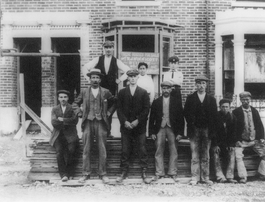
Robert John Winnicott began his business in Portsmouth in 1904 at the age of 21, soon expanding, buying land and building houses in Portsmouth and surrounding areas.
During the First World War, Mr Winnicott served in the Fleet Air Arm and the business was carried on by his staff. After the war the business concentrated on building housing in Copnor and Eastney and by the mid 1930s “RJ’s” son Harold had joined the business and contracting work was added to their activities, in addition to speculative housing. The firm became a Limited Company in 1938.

During the Second World War, the work force was involved in defence work in and around Portsmouth, including making aircraft components in the joiners’ shop. Harold Winnicott served in the RAF during the War.
In the late 1930s, “Deerleap”, a large house and grounds in Rowlands Castle, was purchased as a land bank for housing development. However, with the intervention of Second World War this went by the wayside. Instead, after the war, a branch of the business was established together with a small retail outlet catering for a growing DIY market.
When the founder of the company died in November 1971, aged 88, his grandson Robert took over the business. In 1975 the company moved out of the Portsmouth premises to a newly constructed joinery shop and offices at Rowlands Castle. This was followed in 1976 by the building of a new retail outlet facing The Green.

Following Robert’s retirement in 2004, the fourth generation of the family now run the business. Robert’s eldest son Adrian joined the firm in 1988 and runs the retail hardware side of the business along with cousin David. Adrian’s younger brother Paul, who joined in 2001, runs the construction division.
Photos and text copyright of R J Winnicott’s
